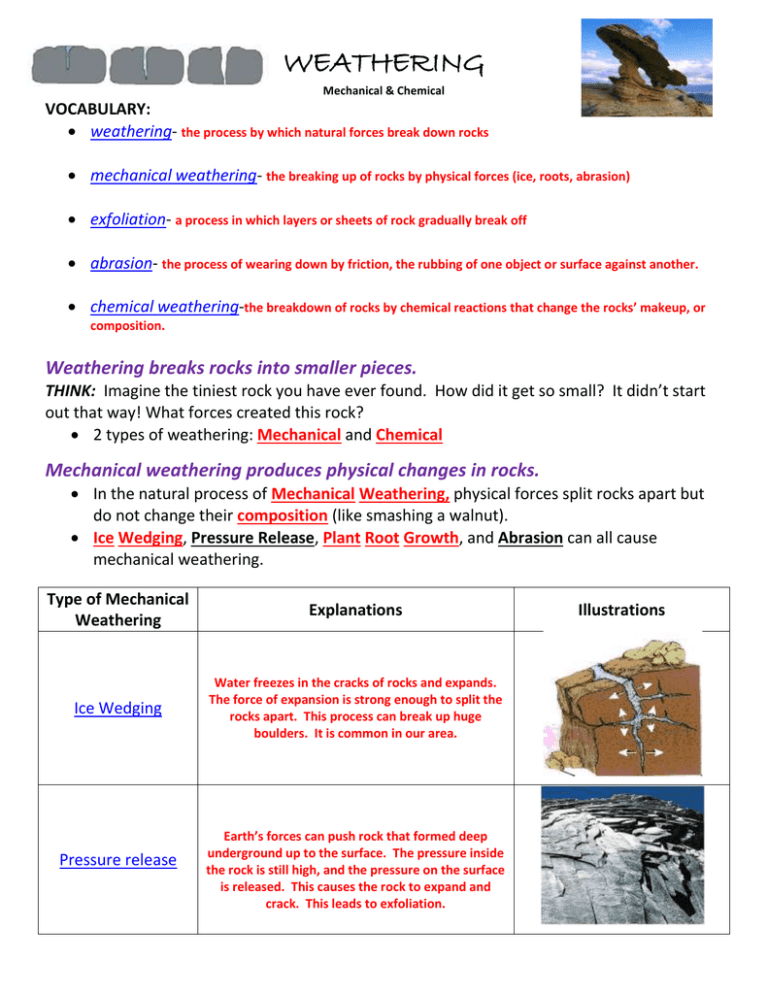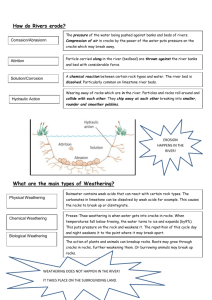Mechanical and Chemical Weathering Answer Key
advertisement

WEATHERING Mechanical & Chemical VOCABULARY: weathering- the process by which natural forces break down rocks mechanical weathering- the breaking up of rocks by physical forces (ice, roots, abrasion) exfoliation- a process in which layers or sheets of rock gradually break off abrasion- the process of wearing down by friction, the rubbing of one object or surface against another. chemical weathering-the breakdown of rocks by chemical reactions that change the rocks’ makeup, or composition. Weathering breaks rocks into smaller pieces. THINK: Imagine the tiniest rock you have ever found. How did it get so small? It didn’t start out that way! What forces created this rock? 2 types of weathering: Mechanical and Chemical Mechanical weathering produces physical changes in rocks. In the natural process of Mechanical Weathering, physical forces split rocks apart but do not change their composition (like smashing a walnut). Ice Wedging, Pressure Release, Plant Root Growth, and Abrasion can all cause mechanical weathering. Type of Mechanical Weathering Explanations Ice Wedging Water freezes in the cracks of rocks and expands. The force of expansion is strong enough to split the rocks apart. This process can break up huge boulders. It is common in our area. Pressure release Earth’s forces can push rock that formed deep underground up to the surface. The pressure inside the rock is still high, and the pressure on the surface is released. This causes the rock to expand and crack. This leads to exfoliation. Illustrations Plant root growth Trees, bushes and other plants may take root in cracks in rocks. As the roots grow, they wedge the rocks open. Large rocks can be split by roots. Abrasion Water wears down rocks on riverbeds and along shorelines by abrasion. The force of moving water alone causes this. Water also causes rocks to tumble downstream. Tumbling rocks wear away as they grind against other rocks. Ocean waves beating the shorelines also cause abrasion. Chemical weathering changes the mineral composition of rocks. Minerals in rocks undergo chemical changes when they react with water and air. Water is the main cause of chemical weathering. In the atmosphere, small amounts of Carbon Dioxide dissolve in rainwater. The water and carbon dioxide react to form a weak acid. After falling, the water moves through the soil picking up additional carbon dioxide from decaying plants. This acid water breaks down minerals in rocks, and may break them apart. Air Pollution from cars and power plants can make rainwater even more acidic. Rusting Oxygen is also involved in chemical weathering. Oxygen, water, and dissolved minerals containing iron produce iron oxides, or rust. Iron oxides form a coating that colors weathered rocks. Weathering occurs at different rates. Most weathering occurs over long periods of time- hundreds, thousands, or even millions of years. It takes hundreds or thousands of years for a very hard rock to wear down just a few millimeters (the thickness of your fingernail). Not all rocks wear at the same rate. Factors affecting the rate of weathering include: the rock’s size (surface area), the composition (granite vs. limestone) and the climate that the rock is in (hot, wet regions weather rocks faster than cold, dry ones).






